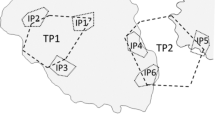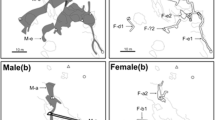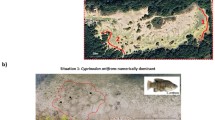Abstract
We investigated the territoriality and the spatial and mating relationships of the haremic hawkfish, Cirrhitichthys falco, on a reef off Kuchierabu-jima Island in southern Japan. Each individual maintained a territorial home range which was defended against same-sex conspecifics at the boundary of the home range. The territory of each male encompassed the territories of 2–3 females, allowing the male to completely monopolize mating opportunities with those females. Based on our observations, we classified the harem type of C. falco as a territorial female type. Large juveniles maintained independent home ranges outside the female territories. In contrast, small juveniles were allowed to cohabit within the territory of an adult female. Stomach contents analysis revealed that the smallest size class of C. falco fed primarily on copepods. In contrast, all other size classes fed primarily on decapods. Together, these results suggest that female territoriality plays an important role in defending food resources.


Similar content being viewed by others
References
Baird TA (1988) Female and male territoriality and mating system of the sand tilefish, Malacanthus plumier. Environ Biol Fish 22:101–116
Baird TA, Liley NR (1989) The evolutionary significance of harem polygyny in the sand tilefish, Malacanthus plumieri: resource or female defence? Anim Behav 38:817–829
Bellwood DR (1988) Ontogenetic changes in the diet of early post-settlement Scarus species (Pisces: Scaridae). J Fish Biol 33:213–219
Carvalho N, Afonso P, Santos RS (2003) The haremic mating system and mate choice in the wide-eyed flounder, Bothus podas. Environ Biol Fish 66:249–258
Clark E, Pohle M, Rabin J (1991) Stability and flexibility through community dynamics of the spotted sandperch. Natl Geogr Res Expl 7:138–155
Donaldson TJ (1986) Courtship and spawning of the hawkfish Cirrhitichthys falco at Miyake-jima, Japan. Jpn J Ichthyol 33:329–333
Donaldson TJ (1987) Social organization and reproductive behavior of the hawkfish Cirrhitichthys falco (Cirrhitidae). Bull Mar Sci 41:531–540
Donaldson TJ (1989) Facultative monogamy in obligate coral-dwelling hawkfishes (Cirrhitidae). Environ Biol Fish 26:295–302
Donaldson TJ (1990) Reproductive behavior and social organization of some Pacific hawkfishes (Cirrhitidae). Jpn J Ichthyol 36:439–458
Gladstone W (1987) The courtship and spawning behaviors of Canthigaster valentini (Tetraodontidae). Environ Biol Fish 20:255–261
Gushima K (1981) Study on the feeding ecology of reef fishes in Kuchierabu Island. J Fac Appl Biol Sci, Hiroshima Univ 20:35–63
Gushima K, Murakami Y (1976) The reef fish fauna of Kuchierabu, offshore Island of southern Japan. J Fac Fish Anim Husb, Hiroshima Univ 15:47–56
Harmelin-Vivien ML (1989) Implications of feeding specialization on the recruitment processes and community structure of butterflyfishes. Environ Biol Fish 25:101–110
Hiatt RW, Strasburg DW (1960) Ecological relationships of the fish fauna on coral reefs of the Marshall Islands. Ecol Monogr 30:65–127
Hourigan TF (1989) Environmental determinants of butterflyfish social systems. Environ Biol Fish 25:61–78
Ishihara M, Kuwamura T (1996) Bigamy or monogamy with maternal egg care in the triggerfish, Sufflamen chrysopterus. Ichthyol Res 43:307–313
Kawase H (2002) Simplicity and diversity in the reproductive ecology of triggerfish (Balistidae) and filefish (Monacanthidae). Fish Sci 68 Supplement I:119–122
Kimoto S (1976) Study methods of animal communities I—the diversity and composition. Kyoritsu shuppan Tokyo: 135–136
Kobayashi K, Suzuki K (1992) Hermaphroditism and sexual function in Cirrhitichthys aureus and the other Japanese hawkfishes (Cirrhitidae: Teleostei). Jpn J Ichthyol 38:397–410
Kohda M (1991) Intra- and interspecific social organization among three herbivorous cichlid fishes in Lake Tanganyika. Jpn J Ichthyol 38:147–163
Kondo T (1986) Feeding habits of Lamprologus savoryi (Teleostei: Cichlidae) with reference to its social behaviour. Physiol Ecol Jpn 23:1–15
Kuwamura T (1984) Social structure of the protogynous fish Labroides dimidiatus. Publ Seto Mar Biol Lab 29:117–177
Kuwamura T (1988) Parental care and social systems in fishes. Kaimeisha, Tokyo
Kuwamura T (1991) Habitat segregation, coexistence or interspecific territoriality between two triggerfishes, Rhinecanthus aculeatus and Sufflamen chrysopterus, with notes on distribution of other balistids at Sesoko Island, Okinawa. Galaxea 10:65–78
Lowe-McConnell RH (1987) Ecological studies in tropical fish communities. Cambridge University Press, Cambridge
Matsumoto K (2001) Overlapping territory of a benthophagous fish, Goniistius zonatus (Teleostei: Cheilodactylidae). Ecol Res 16:715–726
Matsumoto K, Kohda M (2004) Territorial defense against various food competitors in the Tanganyikan benthophagous cichlid Neolamprologus tetracanthus. Ichthyol Res 51:354–359
Moyer JT (1984) Reproductive behavior and social organization of the pomachanthid fish Genicanthus lamarck at Mactan Island, Philippines. Copeia 1984:194–200
Moyer JT, Nakazono A (1978) Population structure, reproductive behavior and protogynous hermaphroditism in the angelfish Centropyge interruptus at Miyake-jima, Japan. Jpn J Ichthyol 25:25–39
Nakabo T (2002) Fishes of Japan with pictorial keys to the species, Englishth edn. Tokai University Press, Tokyo
Nakazono A, Kuwamura T (1987) Sex change in fishes. Tokai University Press, Tokyo
Nakazono A, Nakatani H, Tsukahara H (1985) Reproductive ecology of the Japanese reef fish, Parapercis snyderi. Proc 5th Int Coral Reef Congress 5:355–360
Nemtzov SC (1997) Intraspecific variation in home range exclusivity by female green razorfish Xyrichtys splendens (family Labridae), in different habitats. Environ Biol Fish 50:371–381
Ohnishi N (2004) Sex change of territorial females in the polygynous sandperch, Parapercis snyderi. In: Kohda M, Nakashima Y (ed) Social behavior of fishes Vol.3. Kaiyusha, Tokyo, pp 117–150
Pinkas L, Oliphant MS, Iverson ILK (1971) Food habits of albacore, bluefin tuna and bonito in California waters. Calif Fish Game 152:1–105
Randall JE (2005) Reef and shore fishes of the South Pacific: New Caledonia to Tahiti and the Pitcairn Islands. University of Hawai‘i Press, Honolulu
Robertson DR (1972) Social control of sex reversal in a coral-reef fish. Science 177:1007–1009
Sadovy Y, Donaldson TJ (1995) Sexual pattern of Neocirrhites armatus (Cirrhitidae) with notes on other hawkfish species. Environ Biol Fish 42:143–150
Sakai Y (1997) Alternative spawning tactics of female angelfish according to two different contexts of sex change. Behav Ecol 8:372–377
Sakai Y, Kohda M (1997) Harem structure of the protogynous angelfish, Centropyge ferrugatus (Pomacanthidae). Environ Biol Fish 49:333–339
Sano M, Shimizu M, Nose Y (1984) Food habits of teleostean reef fishes in Okinawa Island, southern Japan. Univ Mus Univ Tokyo Bull 25:1–128
Sano M, Shimizu M, Nose Y (1987) Long-term effects of destruction of hermatypic corals by Acanthaster planci infestation on reef fish communities at Iriomote Island, Japan. Mar Ecol Prog Ser 37:191–199
Shapiro DY (1979) Social behavior, group structure, and the control of sex reversal in hermaphroditic fish. In: Rosenblatt JS, Hinde RA, Beer MC, Busnel C (eds) Advances in the study of behavior 10. Academic, Berlin, pp 43–102
Thresher RE (1984) Reproduction in reef fishes. T.F.H. Publications, Neptune City
Turner GF (1993) Teleost mating behaviour. In: Picher TJ (ed) Behaviour of teleost fishes, 2nd edn. Chapman & Hall, London, pp 307–331
Warner RR (1984) Mating behavior and hermaphroditism in coral reef fishes. Am Sci 72:128–136
Yabuta S, Kawashima M (1997) Spawning behavior and haremic mating system in the corallivorous butterflyfish, Chaetodon trifascialis, at Kuroshima Island, Okinawa. Ichthyol Res 44:183–188
Yogo Y (1987) Group structure and mechanism of sex change in Anthias squamipinnis. In: Nakazono A, Kuwamura T (eds) Sex change in fishes. Tokai Univ Press, Tokyo, pp 148–173
Acknowledgments
We are grateful to the people of Kuchierabu-jima Island for allowing us to conduct the field work. We thank S. Otsuka for providing advice on the identification of food items. We also thank M. Tsuboi, K. Nakamura, K. Nagata, Y. Masui (Blue7C), and Y. Yamane (Blue7C) for their support during the fieldwork. Thanks are also due to K. Gushima and colleagues at the Laboratory of the Biology of Aquatic Resources, Hiroshima University, for their support. Finally, we thank two anonymous reviewers for comments on the manuscript. This study was partly supported by the Mikimoto Fund for Marine Ecology, the Inamori Grants, and a Grant-in-Aid for Scientific Research (C) (21570026) from the Japan Society for the Promotion of Science. This study was carried out in compliance with the current laws of Japan. We would like to dedicate this study to the memory of the late Y. Yogo, who provided considerable support.
Author information
Authors and Affiliations
Corresponding author
Rights and permissions
About this article
Cite this article
Kadota, T., Osato, J., Hashimoto, H. et al. Harem structure and female territoriality in the dwarf hawkfish Cirrhitichthys falco (Cirrhitidae). Environ Biol Fish 92, 79–88 (2011). https://doi.org/10.1007/s10641-011-9817-z
Received:
Accepted:
Published:
Issue Date:
DOI: https://doi.org/10.1007/s10641-011-9817-z




